I Can Do This! The Women of Two Wheeled Expeditions and how biking became their lives.
Anita Krishnan
It’s been years since Anita began her motorcycle adventure, but her sense of joy and wonder has not diminished one bit. A national level basketball player in her teens, who learnt to ride a motorcycle in college, and then tested her skills in a rally, Anita’s attitude has been “I can do this!”
She began her career as an event manager in Bombay, curating product launches and organizing gigs at nightclubs and it soon became apparent that she was a people person. Getting married soon after to a Naval Officer meant more adventure travel and socializing.
Anita’s passion to see women get out on their motorcycles is a reason why she heads the India division of Women’s International Motorcycle Association. WIMA India as the name suggests is part of a global sisterhood, connecting female riders from across 33 countries.
The pandemic has obviously challenged and changed the world as we knew it. Until the beginning of 2020 Anita had also been leading tours with Two Wheeled Expeditions and will continue to do so from 2022. Meanwhile she has been riding solo, exploring some remote parts of India, learning firsthand about ancient cultures and making the most of each day. But she has also managed to do a few trips with her friends.
When asked about the difference between solo versus group travel, Anita’s take is “riding with friends or leading a tour is a lot of fun as each person brings a unique perspective to the same adventure. On the other hand, riding solo means you choose your own pace and its often introspective. You’ve got to pay more attention to how you or your motorcycle is doing…also the kind of places you’re exploring and at what time. With a group those concerns are shared so you are not as worried.”
Curious riders and often girls have asked Anita what it takes to lead a group or run tours. “A road captain has to be very patient and enterprising at the same time. They should have a hunger for travel and to learn. Keep an open mind to deal with people and situations. A bit of technical know-how about your motorcycle will help and you need to have hospitality/people skills to ensure your group is having a good time. It takes planning beforehand, to anticipate what is required so that you can maximize each day.”
In short, you need a “I can do this” attitude!

You may not be following her on Instagram or seen her YouTube videos. Might have even missed her talk on Tedx, interviews on BBC, National Geographic and countless other national and international tv networks.
Candida Louis
Maybe you didn’t renew your subscription to Travel+Leisure or Lonely Planet magazines. Over the last 15 years of motorcycling, Candida Louis has come a long way. Enough to warrant an entire book being written on her, titled “Candid Tales”.
Riding to the furthest corners of India and then across 25 countries, including her epic 2018 trip from India to Australia gave her the exposure and skill to lead over 30 tours. For those who have met her or ridden on her tours, what distinguishes Candida is her grit with grace, and a quiet confidence which says, “I can do this”. Excerpts from a recent interview.
1. How did you go from motorcycling for fun to motorcycling full time?
I’ve always loved being outdoors. I figured that if I wanted to continue riding and taking in all these beautiful experiences, I needed to get a job related to biking and motorcycles. But back then all I could find were jobs like a store manager or accounts related deskwork which meant I’d be stuck indoors! So when I joined a company which was in the motorcycle industry, I suggested we create a different department. They agreed and that’s how I began planning and leading tours in 2016. Along with that I also started teaching women how to ride. Before long I had a full time job which kept me outside on the motorcycle. Gradually I also built a social media following by blogging and vlogging my travels.

2. What were some of the biggest hurdles you needed to overcome to get this far?
My knee dislocations which I had frequently from my school days and the doctor telling me I would never walk again was really tough. Then the first 3 years after I quit my job to pursue fulltime motorcycling were extremely difficult. I used up all my savings including my pf and during those years I did most of the work for free. Which meant I was broke and often I would just lock myself in a room and not meet anyone.
3. A lot of people dream of riding across borders but don’t end up fulfilling it. How did you end up doing the Bangalore to Sydney trip?
I feel everyone has a choice to get up every day and do something, to make a difference. I was really determined to finish Alistair Farland’s ride who tragically died in North America while on his world tour. When I started planning for it I imagined myself on a bicycle because I did not have funds to do it on a motorcycle. But I think if you are determined, work hard enough and believe in the power of prayers, the universe just makes things possible. I was able to do my entire ride in what other people spend on buying a middle-weight motorcycle.
So I never quite get what people mean when they say I’m rich or I’m lucky. The reality is I was able to ride from Bangalore to Sydney because I decided that I could do it!
Wendy Simpson
What would a dad who is in the Police and has seen enough road accidents involving motorcycles tell his teenage daughter when she asks if she can ride one? You guessed it, “no, not even as pillion! They’re too dangerous!” Wendy passed her driving test for a car at 17 and it wasn’t long before she discovered her need for speed. She drove her cars fast, what with them getting fuel injected and having GTI on the back. But her fascination with motorcycles remained. Eventually her parent’s fear and worry could not keep her from saying “I can do this!” Wendy enrolled for motorcycle lessons and even before she passed her test, purchased a stunning R6 in Yamaha blue. Once she got the license, there was no more time to waste. Excerpts from a recent interview:
You finally started riding then you had to stop. What happened?
As it does with many of us, life got in the way of my passion. Between the full time career which required a lot of travel, relationships and family commitments I had less and less time to ride. My poor bike spent more time on the trickle battery charger in the garage until I sold it with much sadness. Unfortunately life got a bit more tough as both my parents’ health started to decline. There was no time between helping them both while working full time. My dad passed away due to cancer and then my mum required constant care due to her Parkinson’s disease and dementia until she passed away recently.

Motorcycling was very much still in the back of my mind and I knew at some point I would get back to it but I also knew I had to wait for the right season.
How has it been getting back on the motorcycle after such a long break?
It has been exciting, nerve wracking and exhilarating all rolled into one! I have been taking refresher lessons to remember how to get back on two wheels. I was so convinced I had forgotten it all that I wondered if I would need to ride with stabilisers! Thankfully I found a great local company called Biketec with really patient instructors, Eric and Heath who have helped me get my confidence back. Thanks to them I feel like I can do this! Heath got me started on a 125cc and now am riding a 650cc around the beautiful Scottish countryside and also through the city in all weathers. I feel like I am almost ready to jump on a plane and ride in Nepal or India!
Any tips to those who may think it’s too late for them to get back to riding?
I would definitely say it’s NEVER too late. If I can do this, you can too. Yes it’s scary and it’s wild to jump back on the saddle of life…but when we are out negotiating all sorts of roads, it’s an inexpressible feeling of being truly alive!
It seems impossible to have a conversation about Covid and more specifically about travel during it without touching a nerve somewhere. The topic is as polarised as climate change, racial equality, immigration and pretty much every other social theme of our time. I am not going to wade into that mire. It’s way too tiring. If you are a person who believes that until Covid is ‘over’, the world should remain ‘sheltered in place’, you might be better served spending the next 10 minutes in your garden. But for those of you who accept our new reality and despite this will continue to live your life, read on.

If you have not travelled much in the last 22 months, especially internationally, one basic fact should be understood: the rules have not only changed, they refuse to remain static. So, if an international adventure is stuck in your near-term mindset, don’t despair. With a lot of stamina and some clever sleuthing, catapulting yourself from your Covid penitentiary into our beautiful world is a few clicks away.
Making a commitment..and when
Let’s be honest: the airlines and companies like AirBnB have been pretty horrible throughout this pandemic. I personally have lost thousands on flights that had to be postponed or cancelled, losses that have posted as revenue to the carriers but a big expense to me. And I know I am not alone. It took a while to figure out the best tactic: don’t book more than 3-4 weeks out. As we all know, our current world can become a very different place in a short period of time so a brief gap between booking and travel constrains this risk. And of course, choose a tour company (like ours, for instance) that has the deepest disdain for large, inflexible airlines and one that treats its clients the way we would want to be treated. This means 100% flexibility of your booking in the Covid world.
Getting ready for departure
Disclaimer: All facts may become fiction without notice.
We field questions daily about the rules for travel. The question ‘do I need to be vaccinated’ is invariably among them. Obviously, whether you vaccinate or not is a personal decision. But if you decide not to, you will encounter a strong (quarantine) headwind wherever you go.
Let the fun begin!
Step 1 – Get International Travel Insurance.
This was a strong recommendation well before the Covid waves started crashing over our beach party. This coverage usually cost about USD75 and covers you for illness and injury during your trip. So ‘if’ you take a tumble and need to come home in first class wearing a cast, or ‘if’ you contract the dreaded Omicron or some other letter in the Greek alphabet and require some hospital time, you can rest assured that you will not have to max your credit card getting the care you need. Allianz is a good one that we use, but there are many out there.
Step 2 – India & Nepal – Your ticket to the big show
Time to get real: if you want to travel internationally, you are doing yourself a disservice by not getting vaccinated. That said, this is your choice so if you are down with the facts and don’t mind sitting in a quarantine hotel at your expense, have at it. Once you are past this, the process is straightforward: get a PCR test prior to your flight (how long before varies but usually no more than 72 hours), complete your Passenger Locator Form for the destination country, get your visa and off you go. See? Simple.
Step 3 – Staying safe on road
Once we’re on the road, everything is pretty much as it always was. Kathmandu or Delhi traffic madness (the best video game in the world), stunning vistas, winding roads, sublime food, beautiful smiles. Wearing a mask in hotels and restos is left to the guest although they are still required in taxis and busses. We wear them to keep the dust out of our lungs but short of that, your adventure rolls on as your dreams imagined. Let the awesome unfold!

Step 4 – Getting ready to make your way home
We expect the service level of our hotel partners to be equal to that of our tour company. That means we take care of everything. 24 hours before you depart, our base hotel in Kathmandu, Delhi or wherever will arrange for a reputable local lab to come to the hotel and take bio samples from our entire ride crew. 8 hours later, the results are delivered and you are ready for re-entry.
Step 5 – Navigating your arrival
This is where things become variable based on your home country. Most require the completion of a Passenger Locator Form that essentially captures all your personal data including your vaccination status, your negative PCR result and proof that you have booked a PCR test to be taken upon your arrival back home. (As I write this, the UK has just done away with this silliness but who knows, the madness may yet return.)
The happy ending to this bureaucratic ball of twine is that it really isn’t that difficult. Like adventuring around India or Nepal for 12 days on a motorcycle, it may seem daunting but once you’re done you’ll give yourself a pat on the back and wonder what all the fuss was about. And as far as the riding is concerned, you’ll kick yourself for waiting so long and start planning your escape to do it all again!

Sri Lanka, Ceylon, Serendip – This emerald island nation nestled between India and Southeast Asia in the Indian Ocean has carried many names over the past 2,000 years. Sri Lanka, the country’s name since the 1970’s, seems to exemplify its characteristics better than the others: ‘Sri’, meaning ‘resplendent’ and ‘Lanka’, the Sinhalese word for ‘island’ and you know exactly what you are getting.
The first time you get on a bike and start to make your way around this island paradise, one specific question flashes through your mind: why did it take so long to do this? Forget about the stunning beauty of the place, the myriad cultural icons, the fabulous food or the sublime beaches because I will talk about these in a second: It’s the endless, perfectly maintained winding roads through national parks, tea plantations and mountain jungles that places Sri Lanka in the highest echelons of adventure motorcycling bliss. Now for the breakdown:

- The Beaches
Lest we forget, we are on holiday here and holiday for most people usually includes some beach time. It is here that we switch off and soak in the acoustic accompaniment of lapping waves and a good dose of sunshine. Sri Lanka has 1,342 kilometres or 832 miles of coastline and, no matter where you go, you will be hard pressed to find one with a crowd. Spare the odd herd of wild elephants (yes, really) most beaches are yours to explore. And because the country is a mere 550 miles or 880 km from the equator, the clear blue Indian Ocean surf surrounding your feet is warm and inviting.

- The Mountains
As soon as you feel the equatorial heat making you feel a bit grumpy, it’s time to head to the mountains. The Knuckles Range, a UNESCO World Heritage Site in the country’s core snakes us up to 1,200 metres or 4,000 feet and enshrouds us in a beautiful mist that turns the scene into a fabulous water colour at sunset. Up here you will find richly architected tea plantations to call home for a night or two while you take an evening meal of locally sourced Sri Lanka cuisine on a veranda.
- The Food
As you would expect, the dishes are awash in the local flavours of the tropics: Coconut, limes, seafood, an array of spices, dals and rice, whether enjoyed at a roadside stall or a fine restaurant in Colombo or Galle, you have to try exceptionally hard to be disappointed. Grab a cooking class on your down days and bring something truly magical home with you.

- The Wildlife
You don’t have to wait to be on safari to start spotting the incredible species Sri Lanka is home to. Endless winding country lanes, their boundaries strung with electric fencing, tells you you’re in elephant country. Spotting a wild elephant on a one of these roads or indeed on the side of a highway or strolling along the beach is not at all uncommon. It’s once you arrive at one the country’s many wildlife parks and refuges that the animal kingdom really comes to life: crocodiles, wild boar, deer, langurs and macaques abound and if you are really, really lucky, a leopard may cross your motorcycle’s path.
- The Roads
If all those characteristics of this exotic island are not enough for you, then there is one common denominator that binds us all: the bike and all those glorious roads. You want muddy tracks through rice paddies? Fit the knobbies and get as filthy as you like. Wide, swinging twisties more your thing? Head to the mountains and lean your way to hillstation heaven. A nice coastal jaunt as Indian Ocean breezes soothe your face? The 1,300 kilometres of coastline will ensure you never, ever run out of beach.

Don’t Think. Go.
Sri Lanka, you may have read, is in a state of turmoil right now and we sincerely hope the situation rights itself soon. But, as is often the case with the news, the images that flash across your screen seldom tell more than a tiny fraction of the real story. Sri Lanka is still fully committed to its tourism industry and, to be honest, the best thing anyone considering traveling to this part of the world should do is exactly that: Go. You will be rewarded with a nation of endless natural beauty, kind people, marvellous cuisine, and breath-taking cultural icons. And they will benefit from a much-needed resuscitation of their vital tourism industry.
I posted a self-deprecating meme a month back consisting of a montage of 5 photographs. The first, in a shot of me at my motorcycling zenith wearing my Vanson race leathers, I’m proudly displaying my race-prepped Ducati 996. The caption reads ‘I’m committed to Italian sport bikes and that is it.’ The second shot shows me on a BMW GS somewhere in Iran and states ‘I will never own a BMW: They’re for old people.’ Next comes me a astride my 40 year old BMW R100 and the cocky line exhorts ‘I will never own a vintage bike. They’re for geriatrics.’ The final image sees me and my girlfriend in our R100/Sidecar combo getting ready to join the Distinguished Gentlemen’s Ride in London. Of course, the misguided text claims that. ‘As long as I can stand, I will never, ever own a sidecar.’ Obviously my words are quite tasty because I dine on them a lot.
And you may ask yourself, how did I get here? It all started with a realisation that is founded in the ethos of Two Wheeled Expeditions: For me, sharing great experiences creates a sublime level of happiness. One day, one glorious day, I was doing what I often do on a sunny Tuesday afternoon: riding my old BMW with zero plans or destination through central London. The meandering path synchronises with my wandering mind like therapy as I discover streets, shops, parks and whole neighbourhoods I never knew existed. And then the epiphany: I wanted to share this beautiful experience with my girlfriend, her daughter, our dog Tupac and everyone I knew! I promptly logged onto Amazon and ordered some Doggles.
Fast forward to a small workshop in the beautiful Cotswolds countryside and the century-old home of Watsonian Sidecars. With tools that have been in use since the company’s founding, these craftsmen create beautiful bolt-on cockpits of fibreglass and steel that are the standard of the sidecar world. I opted for the GP Manx, not because of its stunning looks or exceptional build quality (it possesses these in spades), but because it was at hand. Either join the 6 month wait list or ride away with this masterpiece. I didn’t even need my brain. With a swipe of the Visa, I was steaming toward London.

I’d like to throw out a cool Fight Club line here and exhort ‘there is only one rule of sidecarring’, but sadly there are two so it doesn’t work. Rule 1 of sidecarring is never forget the sidecar is there unless you really hate your passenger. You may laugh, but this is very easy to do. Jumping into the cockpit and letting a friend take the handlebars saw me nearly go teeth first into a nearby Toyota bumper in a matter of metres. Rule 2 is less perilous: always factor the ‘sidecar lag’ into your ride plans. Regardless of where you go, you will be photographed, videoed, queried, chatted up and wooed by shoppers, bus drivers, kids, policewomen, members of Parliament, canines and pretty much any living creature you come in contact with. Put on your best Brad Pitt face and roll with your newly found fame because sidecars bring joy.

Now as bikers, I’m sure the burning question on the tip of your tongues is what it’s actually like to ride one. In a nutshell, it’s pretty fucking weird at first. Let’s start with the obvious. Motorcycles turn by leaning and leaning is initiated through counter-steering. It’s funny how my riders don’t know that. At your next pub meet, ask someone which way they pull the handlebar to turn right. Right? BAAAP! Wrong answer. You pull the left handlebar (and push the right) to turn right. When a sidecar is attached, you do the opposite. Pull the right handlebar toward you to turn right. Hard. The ‘hard’ exclamation cannot be overstated because riding with a sidecar requires a lot of upper body work. Especially at speed, you will be working those arms hard to get the 3-wheeler to obey but think on the bright side: in a matter of months you’ll look like Arnold in his prime.
A final tip. In the UK, sidecars are mounted in the left because, since we drive on the left, this keeps the sidecar, and the passenger you love, out of the path of oncoming traffic. When you turn hard to the right, the sidecar acts like an outrigger. You can turn as hard and fast as you want and that 3rd wheel will keep you planted. Turn hard left, however, and an empty sidecar will quickly lift off the road surface. This may look cool but the cartoonishness of a bike on its side, the sidecar towering above, may lead to undue embarrassment.
I can honestly say that my old BMW R100 gets used ten times more now that it’s grown its sidecar appendage. My girl beams every time I pick her up at work to save her yet another sweaty journey home in the London Underground. My friends’ kids line up to take turns in the Harry Potter mobile. Even Tupac, our German Shorthaired Pointer, has gotten over his initial trepidation and gleefully holds his head above the windscreen as we ride, his soft, floppy ears waving in the wind like socks on a laundry line.

The lesson I learned from all of this is motorcycles are fun. All motorcycles. Dirtbikes, racebikes, enduros, boxer twins, thumpers, sidecars, all of them. Except trikes. I’ll never, ever own a trike. They’re for old people.
I had a dream about my new Klim Badlands Pro riding suit the other night. Or maybe it was a nightmare. The Cordura and Kevlar mass had morphed into a Transformer, Artemis Prime style, and raged though our serene beachside chill spot smashing our Royal Enfield Bullets to pieces. The reality is not far from the dream. Fresh off the rack, the Klim Badlands Pro Jacket and Pants feel like they want to jump to life, swagger across the room and kick the crap out of you. They feel that tough. Putting the new set on feels like donning an exoskeleton. Bring on the battle. Sri Lankan style.

On the flight to Colombo to conduct a refreshed recce of our newest Sri Lanka tour, I am reflecting on the first recce we did there a year earlier. It wasn’t monsoon season but the island doesn’t play by those rules. Each part of the country has its own climate and the deluge followed us around like a stray dog. Every day for the first 4 days, we rode through a perpetual carwash of aquatic ferocity: knee-deep muddy rice fields, flooded village roads, angry streams – we got it all. The Italian adventure jackets we had purchased for our company for their lightness, modularity and reputation were not cutting the chutney. Water penetrated my ride pants and trickled down my legs filling up my waterproof boots over and over again. The jackets, which had the baffling design of placing the waterproofing Gore-Tex layer in the inside of the jacket rather than as its external layer, swelled up to twice their dry weight with water. It was no catastrophe: the rain was warm and we were doing the thing we love most: Creating a new ride experience. But ultimately, this gear that we loved on our drier rides in Nepal, Rajasthan and Ladakh were a ‘big no’ for southern India and Sri Lanka.
Cue to something new.
I have been using Klim Mojave pants for some time. They are a simple shell and are great for Mojave, Thar and Sahara Deserts, albeit with my own armour. I have also loved the summer and autumn season gloves from the same maker. Great and great. But the foray into a complete suit was new ground for me.
My first impression suiting up for the ride from Colombo up the Indian Ocean coast to Kalpitiya was ‘wow, that’s a lot of pockets.’ 18, to be exact. At one point I tried to fish out my passport to check into our hotel only to find that I could feel it but somehow couldn’t get to it. Like trying to figure out which of my 4 smoke detectors is making the bloody low battery chirpy noise. Of course, I can’t toss Klim a foul flag on the design. I am sure that, with time, my jacket’s new Dewey Decimal System will take shape and every pocket will have it purpose.
Here is what I loved, and what did not.
- Ventilation – Galle, Sri Lanka’s UNESCO World Heritage city, sits a mere 440 miles / 700 km north of the equator so, accordingly, I feared I was going to dissolve inside the suit in the sweltering heat. Not so. Maybe they designed it in a wind tunnel, but once you get moving, I stayed as cool as deep sea cod. There are 8 (!) vents in the jacket alone and they work exceedingly well. Stop for a tea break along a jungle road, however, and you’ll be popping popcorn in there in minutes.
- Pockets – As mentioned, there are many, many pockets. Too many. When you inventory all the stuff you normally cram into a suit before hitting the adventure trail, the list is finite: Passport, wallet, sunglasses, revolver, currency, phone, lip balm, keys. So 8, maybe 10 max would do the trick. 16 is just showing off. There’s even a jacket pocket at the back above your waistline that reminds me of a game pocket from a hunting jacket. I did slice a 2-metre viper in two with my wheels on a narrow rice paddy track (still feel sorry for that guy) that I theoretically could have snacked on later, but short of that I have no idea what to do with the game pocket. Maps perhaps? But who uses those anymore?
One other point: all pockets are not created equal. I love the inside jacket pockets lined with armour to (perhaps) protect your iPhone when you face plant. But even more so, I love the front breast key pocket. Never in the history of human civilisation has a wiser pocket been devised. - Aesthetic – I am short and for some reason wearing a clunky suit tends to make me look like a Mighty Morphin Power Ranger. I don’t know if it’s the cut, the design or my stellar physique, but this suit did not make me look like a Morphin. Or at least I don’t think I did.
On the negative spin, with the exception of ‘Peyote – Potter’s Clay’ and ‘Stealth Black’, (a big no-no in hot South Asia where we run our tours) all the other colour configurations look like they were randomly selected from a pile of crayons. - Armour – I didn’t crash but there is CE Level 2 armour everywhere. The pants did shield me from viper and dog bites but otherwise, the armour went untested. My only complaint, and I hope the nice folks in Idaho are listening, is that weird tailbone plate in the pants. Ever throw on your jeans fresh from the dryer and realise there’s a sock inside along for the ride on your backside? That’s the feeling the buttplate gives. Sitting on rocks or logs or hard plastic stools as you do during these rides places unpleasant (best word I could find) pressure on the very bone it is meant to protect. Maybe my tail is longer than most, but I might banish the buttplate and take my chances.
- Weather-Proofing – For the first time ever, I prayed to be blasted with a storm. Unlike last year’s monsoon recce, this one was brilliant sunshine throughout so could not assess the suites watertight-edness. But with most pockets and their zippers being thoroughly treated and the material Gor-Texed from top to bottom, I have faith that I’d have been dry as a martini.
- Biomechanics – Sounds esoteric, but it’s important. The Klim is as flexible as a suit of armour when unpacked. I fretted that trying to throw my leg over the saddle would be like riding in a body cast. It wasn’t. After throwing the jacket to the dirt like a spoiled child at every tea break for a couple of days, it was as supple as my granddaddy’s baseball glove. In no time, I was doing motorcycle yoga like a guru.
- Hydration – Wow, really? We often ride with Camelback hydration packs Rajasthan, Nepal, Kerala and Ladakh. I never liked them because they obscure the embroidered ‘Two Wheeled Expeditions’ logo on the back of jackets, stitching we paid a tidy sum for. The Badlands jacket has a built in (my partner Josh had a mind melt event about this) hydration pack pocket in the back of the jacket, MotoGP style, with pre-built tube routes to get the water to your mouth. Wow. So much wow.

Is the Klim Badlands Pro suit the best adventure riding apparel in the history of the universe? I was going to say no, that’s not possible, until superb customer service and a ‘you thresh it, we refresh it’ policy pushed me over the edge. The answer you seek is yes. Yes, this this is the best adventure motorcycling suit ever conceived. However, (and this is a mighty however) it is really expensive. At USD2000 for the pants and jacket, you might think this decision a bit mental. But if you run adventure tours for a living, or adventure riding is a massive part of your life, or you just have hundos lying all over the floor, you are going to find it tough to buy a better exoskeleton to project your hide from the battle outside than Badlands.
When the news of BMW’s latest GS incarnation flashed across some app somewhere, I swiped left. The first thought that came to mind was ‘have they lost their effing minds?’ Did they not see Ewan MacGregor and Charlie Borman in tears as their GS’s fell for the N-teenth time on the Road of Bones or some other gruesomely named off-road stretch? “Too heavy!” they whined. “Big mistake”, they sobbed. I rode my 2007 1200GS around the world and the only reason it made sense in retrospect was that my future ex-wife was on the back seat and I needed the storage. I remember sitting on a 1250 Adventure in a showroom once and proclaimed it a stroke of madness. Unless you are a hardened Dakar racer, riding that bike offroad would be zero fun. So, when the time came to upgrade my 1200GS, I went to the KTM 790 Adventure. It eats miles for breakfast on the motorway from London to Marrakesh and then magically transforms into an enduro once the pavement ends and the Sahara begins. My sweetspot has been found.
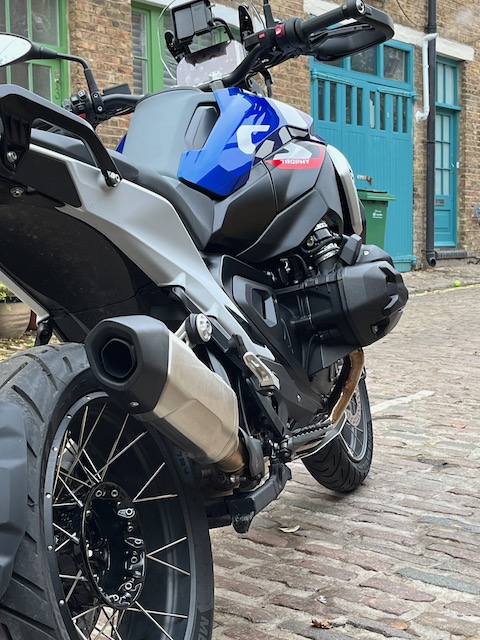
So yeah, I swiped left on the 1300. But then, somewhere, I came across a bike review and read about the total ground-up redesign of the bike. One of the biggest complaints I had on the recent versions of the bike was girth and top heaviness, attributes that are not particularly welcome on the undulating, unpredictable surfaces found once the pavement ends. But when I read the centre of gravity has been significantly improved by placing the gearbox under the engine rather than behind it, I decided to keep reading. Words never uttered to convey the Gelände/Straße’s stature – ‘slim, light & agile’ – kept appearing on my screen. 3 days later, I was riding one through London.
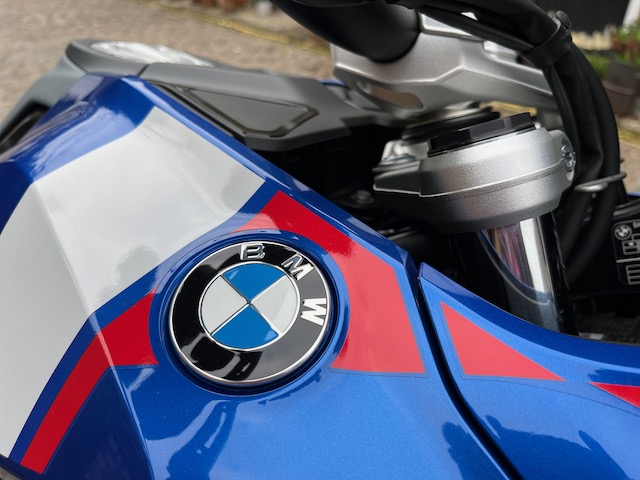
I’m 5’7” and several other fractions tall (i.e, not tall) and the biggest complaint anyone under 5’9” always has is it is too tall. I don’t remember the last time I was flat-footed on any adventure bike (never) so I am pretty used to using the balls of my feet. But this bike has a mind-blowing solution to the seat height / ground clearance conundrum: a suspension that can lower itself by an inch and a half as you come to a stop and then raises itself as you ride away! My test bike didn’t have this feature but wow – what a great innovation!
Despite the lack of this wizardry on my test bike, the first time I creaked my leg over and gave it the hard jerk needed to get the tall, heavy bike off its side stand, I noticed the difference in balance. With the centre of gravity so low, it came upright with surprising ease. The bike felt lighter, more nimble and hence more flickable while doing a dance between the buses, taxis, Bentleys and the ultimate pariah – UberEats scooters – of London traffic. Find a hole, squirt power, go.
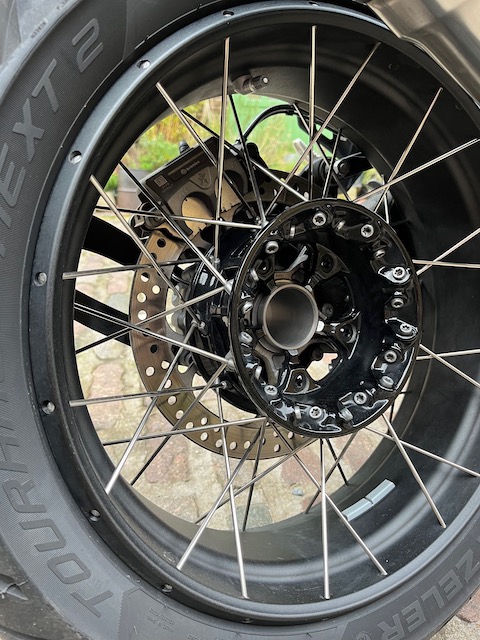
I have a 1974 BMW R75 bolted to a Watsonian sidecar and I ride it around London all the time. The half century old drum brakes have the worst arrestng power in the history of stopping. The brakes on this GS, from the same company but 50 years later, are a masterpiece. Or in my notes, ‘like custard’. Smooth, consistent, reassuring. Even with one finger, they have a progressive feel from the lightest touch to the hardest, ABS-releasing grab.
On propulsion, one thought came to mind: if Tesla made a motorcycle whose motor provided a completely linear relationship between twisting the throttle and forward movement, it would feel like this. I don’t even care what the horsepower and torque numbers are: I can feel it and it is perfect.
And finally, the aesthetic. How does its appearance make you feel? It reminded of the new Africa Twin I test rode in 2019. Every bit looked refined, robust and important. The spoked wheels are sublime. The engine doesn’t look like an internal combustion engine at all. It looks more like a mystery power source powered by crystals or alien life juice. There are no cooling fins. It’s power-coated black. It is omnipotent. The ‘X’ shaped LED headlamp is interesting, but the weird guy who has designed Dada-esque GS headlamps for 25 years seems to always get his way and is always ahead of his time. A board member (Elon Musk?) perhaps.
The wheels, especially the rear, looked jacked from a scooter. I thought it was the clearance that made it look small, but no, the rear is only 17” and the front 19”. Why oh why, if this is ever meant to be taken off-road? I’ll ding you here, BMW.
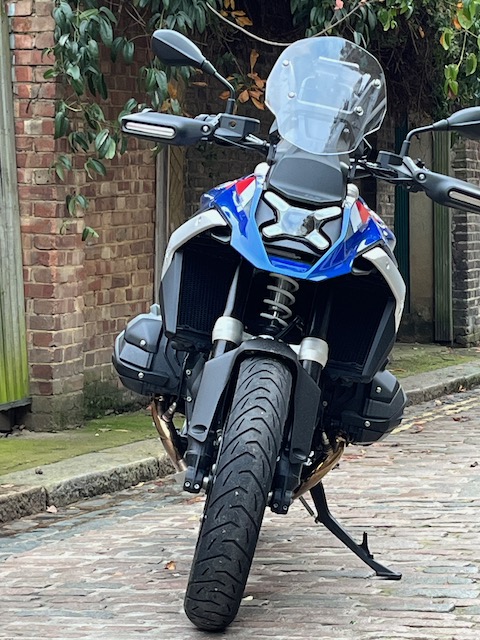
In the end, the new bike has somehow lost some of its GS-ness. The chunky two-wheeled rhinoceros of the past has been dismissed for a spritely kudu. Sure, when you look at its girth from behind it’s still got the shoulders of an NFL linebacker. But viewed from the side, it’s gone from Valerie Adams (Google her) to Kate Moss and this is a good thing: I’d take Kate over Valerie anytime I’m riding through endless mud tracks in Cambodia.
Of course, when I arrived back at the hyper posh BMW of Park Lane on London’s Hyde Park to return the bike, I was accosted with the hard sell. ‘Sorry mate, you can’t sell a seller’, I said. ‘Well, what did you think of it?’, the young Aussie pried. ‘It’s a solution looking for a problem’ was my response and I let him chew on that while I walked out the showroom door, jumped back on my KTM and popped off the sidewalk onto Park Lane toward Buckingham Place.
Let’s start with the question asked repeatedly in the weeks following our tour design ride in Bhutan: What’s it like?
The first thing that strikes you is cleanliness. Crossing the border from India to Bhutan is like stepping through a portal to a place 1000’s of miles away. There is no sound. (horning, a national pastime in India, is banned). There is no rubbish on the streets anywhere. There is order. Smoking in public places is banned. No brash signage shouts for your attention. Breathe deep and let the clean mountain air fill your lungs.
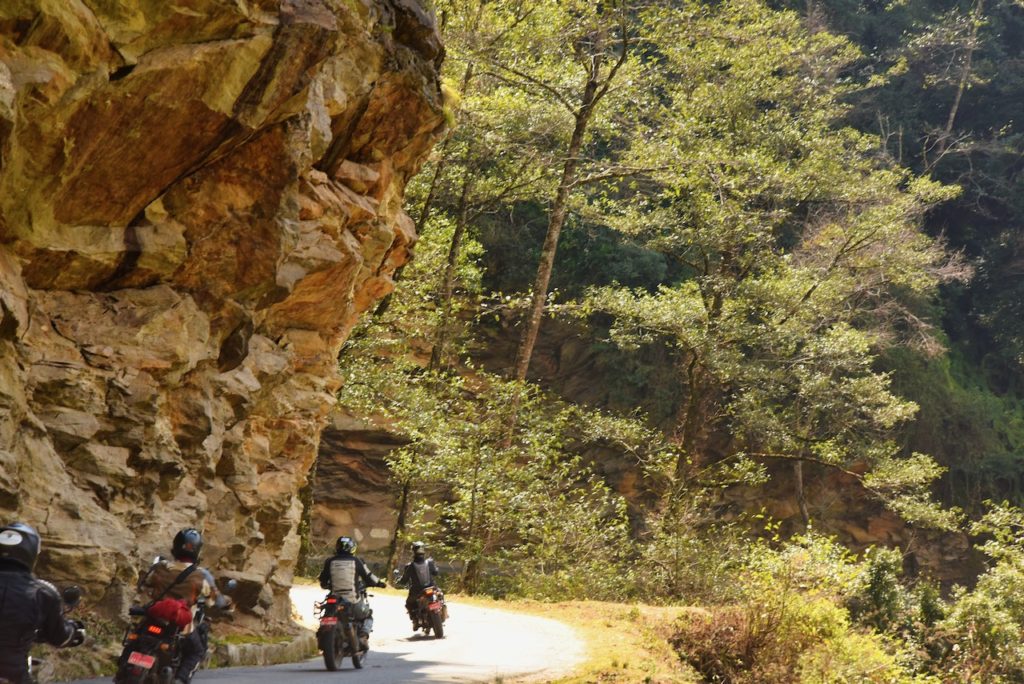
Secondly, the people. Those familiar with India would know that traffic attitudes toward ‘two wheelers’ can be an aggressive affair. In Bhutan, the car, truck or bus ahead of you will have their right signal on to inform you it is not safe to pass. When they switch to the left indicator, they are saying ‘you are good to go.’ They do not merely acknowledge your existence, they aim to protect it. Whether on the road or in a shop and whether fostered by its Buddhist roots or the guiding hand of its King, people come across as innately kind. The place creates a plane of peace and relaxation through its people.
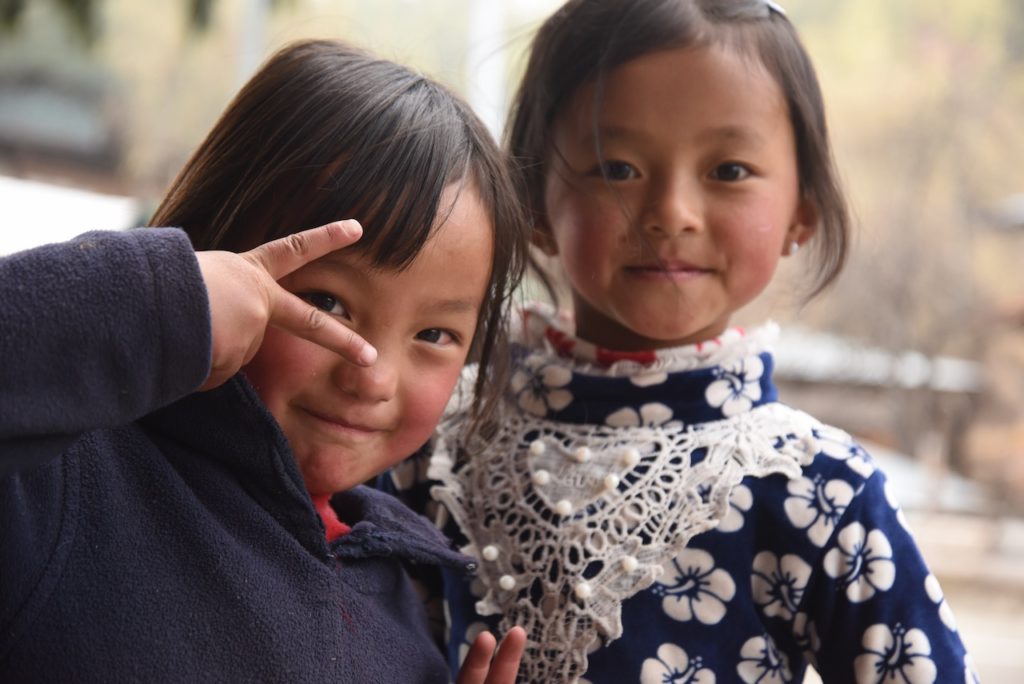
This Himalayan kingdom, closed to the outside world until the mid-70s and shrouded in mystery for some many centuries prior, finds itself tightly wedged between the superpowers of China (Tibet) and India. And while the country’s marketing machine may have succeeded in publicising, ‘Gross National Happiness’ as its guiding light, it’s how this principle manifests itself in its people that is the country’s most beautiful trait.
Bhutan is a small country, only slightly smaller than Switzerland, but its tiny population of only 770,000 and its endless, winding mountain roads make it seem like one of the most remote places on Earth. This is why, for motorcyclists and trekkers alike, it is a magnet without peer. Along its pristine rivers or perched on soaring cliffs, the landscape is a perfect symbiosis between the natural world and the one created by the Bhutanese people.
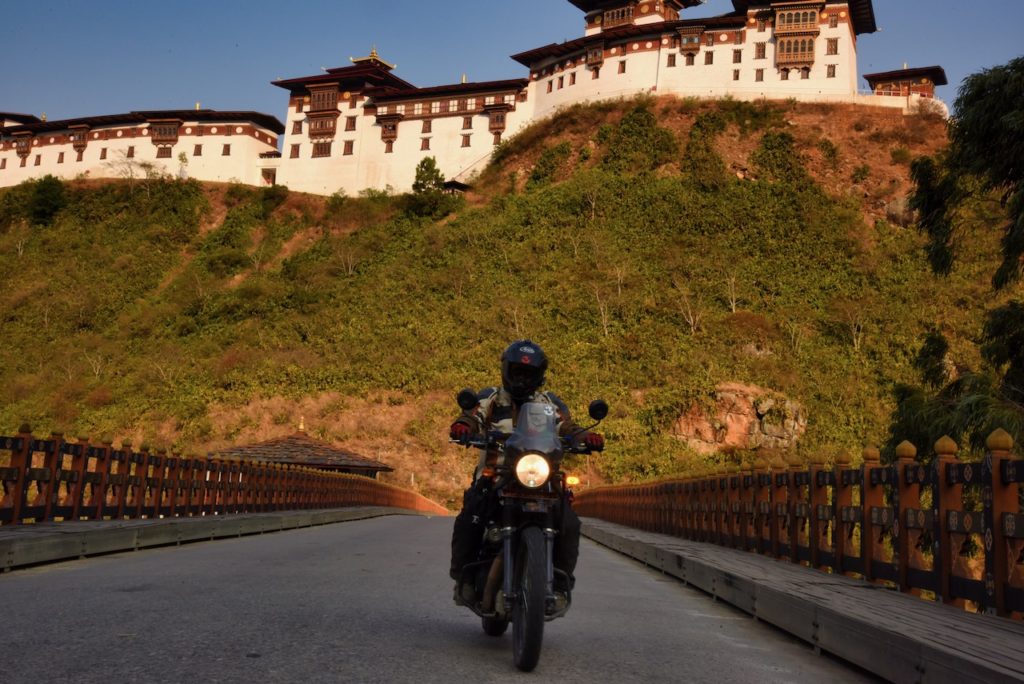
On tourism, Bhutan is famous for taking a different path, a strategy designed to grow tourism sustainably. Firstly, a traveller does not simply arrive and make their own itinerary. All travel plans need to be made through a government-certified Bhutanese tour operator. In addition, as a means of keeping over-tourism in check, the country levies a daily fee on all guests. This fee was lowered from USD250 per day to USD100 in the past year, but the effect is still palpable. Even when making the 3-hour trek to the cliffside Tiger’s Nest temple complex, without a doubt Bhutan’s most iconic site, the volume of tourist traffic is relatively low yielding a more intimate and infinitely more pleasing experience.
The Environment
Another admirable facet of the Bhutanese approach to ensuring the country retains its natural beauty for generations to come is its commitment to land preservation and the environment. Its status as one of the only carbon-negative countries in the world is driven by effective use of hydro-electric power (it uses less than it produces and exports the surplus to India) and its constitutionally mandated preservation of 60% of the country’s landmass as undisturbed forest. The current level stands at 70%. All these wonderful, responsible policies translate to one of the most rewarding travelling experiences to be found anywhere in the world. And when combined with the freedom and exposure of a Royal Enfield Himalayan as our means of exploration, Bhutan ranks as an adventure motorcycling experience like no other.
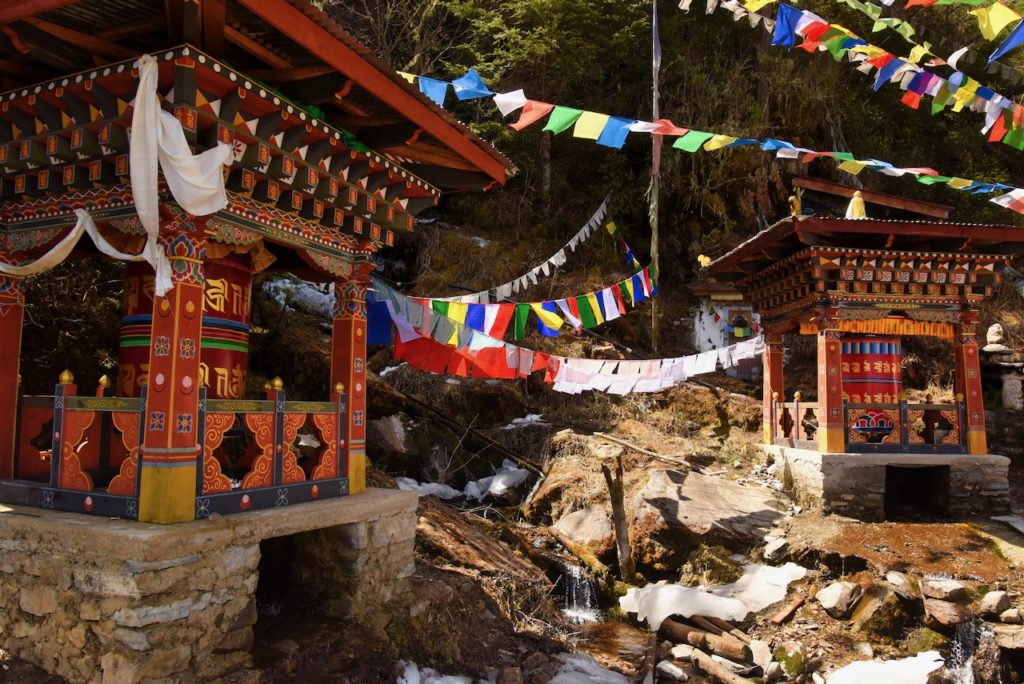
The Route and its Features
Our route took us on a 12-day exploration of a large swath of the country. The whole experience kicks off with an arrival at Paro International Airport. With a runway extending along the valley floor and mountain ranges at either end, it offers an apt introduction to the rugged topography of the country. Rather than settle in Paro at the beginning and end of the tour, we make our way via a quick bus ride up to the capital, Thimpu.
Situated at an elevation of 2,300 meters and with a population of less than 100k, Thimpu has the vibe of a ski town. With an incredibly ornate style of architecture that is uniform throughout the country, squinting your eyes you may think you have landed in the Austrian or Swiss Alps. On the bikes, it’s a short ride to one of the most impressive sights Thimpu has to offer, the Buddha Dordenma, a 51-meter tall, gilded statue of the Buddha placed on a hilltop that commands a view of the whole valley. This is a fitting spot to kick off our journey.
Heading east, we toss the bikes from side to side along sublime mountain sweepers, our groove only amplified by the magnificent vistas on the road to the glacial valley town of Gangtey and from there, Bumthang. Like elsewhere in the country, we are accompanied by a chorus of the ‘hellos’ of schoolchildren who bolt from their homes on hearing the sound of our bikes.
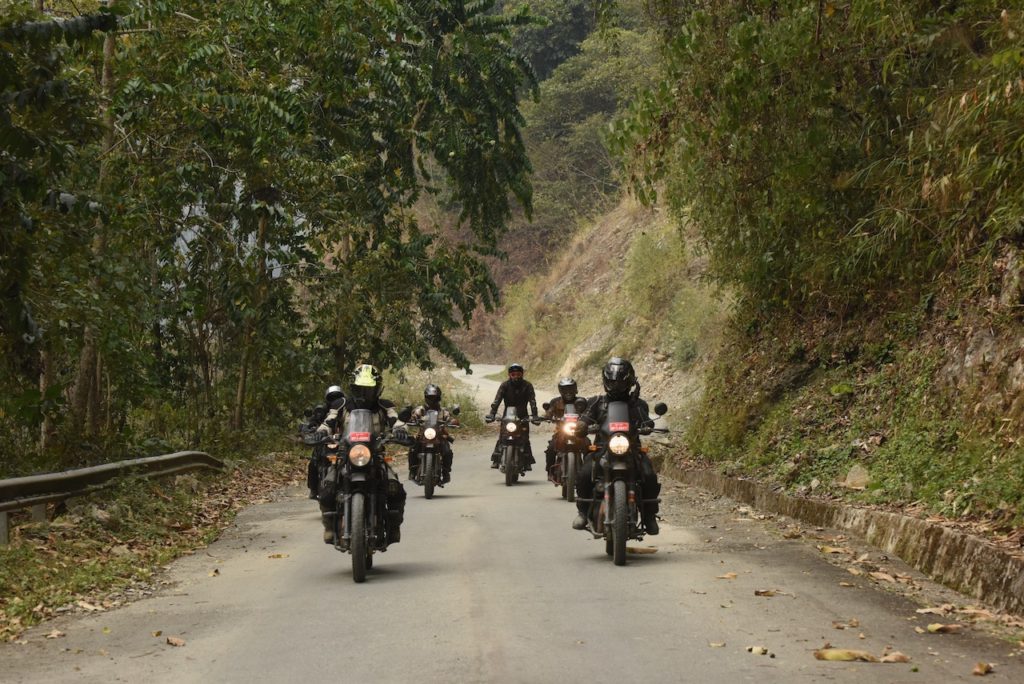
From here, the comparisons to Switzerland become even more pronounced. The elegant consistency of Bhutanese architecture draws parallels to that of the Swiss countryside, and the perfect road surfaces and endless mountain views could lead you to order rösti at lunch instead of the ubiquitous momos. We are only shaken from the tarmac bliss by a rough transition to rocks and gravel 12 kms from our final resting place for the night. A bit of grit was more than welcome…this is why we came!
It was not until we rolled out of the beautifully named town of Tingtibi and its good roads and beautiful scenery that we finally begin to descend. Here, the vegetation becomes more tropical we near the Indian border. The town of Gelephu straddles India and Bhutan and introduces us back to civilisation and Bhutanese whiskey for a night.
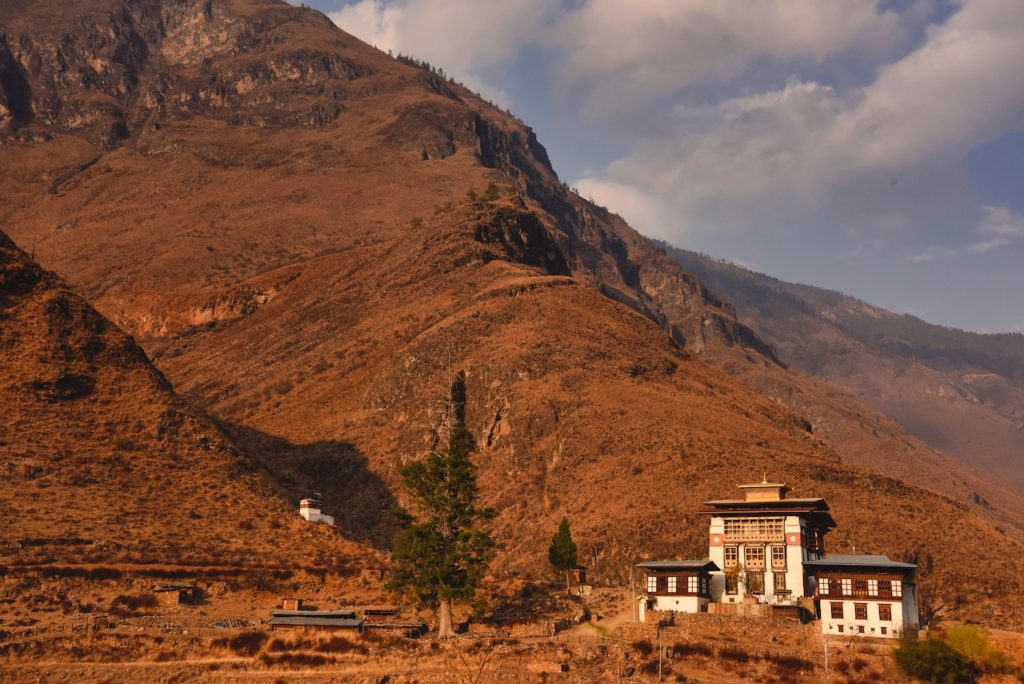
Whiskey haze somewhat shaken, the next stint, takes us along the Indian border for 35km of valley floor riding and the only straight roads in the country. From there, we once again start climbing passing dramatic, remote cliff-side waterfalls along the way. Towards dusk, we reach the town of Punakha, a beautiful town and home of the most striking example of Bhutanese architecture, Punakha Dzong or fortress. A day off the bikes provides some latitude to visit the Dzong, try our hand at the national pastime, archery, and a meal at a now famous homestay kitchen high in the hills around Punakha.
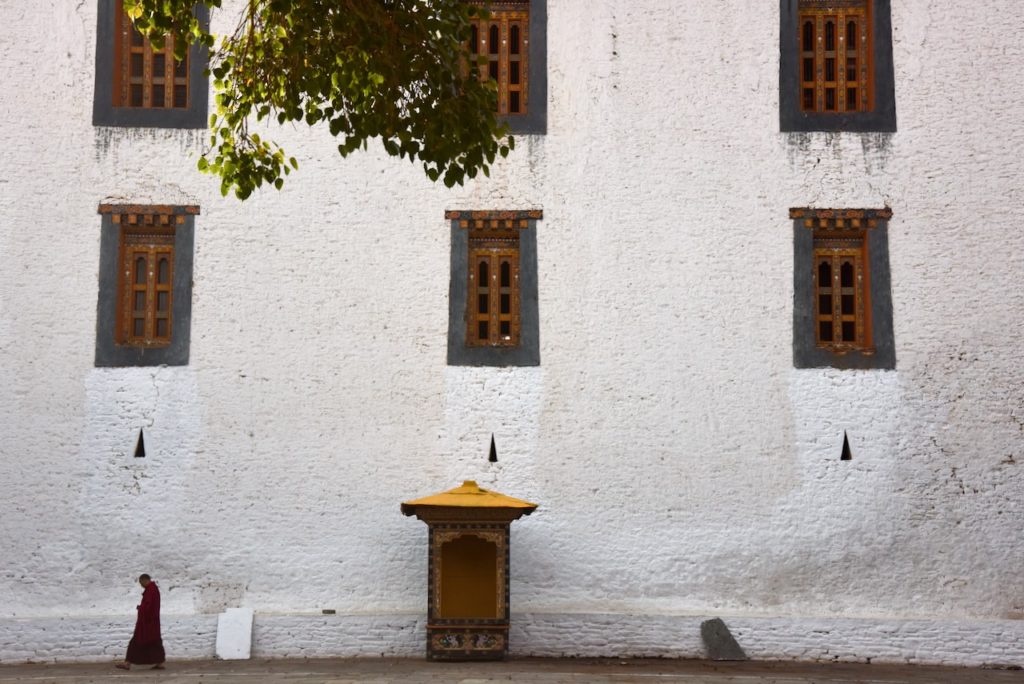
Our final stretch to Paro takes us over the highest motorable pass in Bhutan, the 4,000-meter Cheli-La Pass. Back in town, the Paro valley is a lovely way to end the adventure. Willow trees and apple orchards line the roads, rustic farmhouses and temples augment the beautiful rice fields, and verdant hills rise on either side to create a beautiful and serene whole.
The Conclusion
There is simply no place on Earth like Bhutan. The mountain vistas are endless, the natural beauty of its rivers and waterfalls are untouched, the people are the kindest found anywhere, and its architecture, pervasive throughout the country, is in complete harmony with the landscape. For the motorcycle adventurist, it is heaven. The 24,000 curves, beautiful accommodations, exotic food and the kindest people on Earth will make you fall in love.
Whether crossing the 18,000ft Khardung-la Pass in Ladakh, traversing the Thar Desert in Rajasthan or winding through the endless twisties of the Western Ghats mountain range in southern India, I never tire of shouting the same phrase through my helmet intercom to my partner Josh at the lead of our ride group: ‘You know what, Josh?? We have the best jobs in the world!” And he never gets sick of reassuring me that, ‘yes, Roro, we sure do!” So what could possibly top sharing what we love most with a group of like-minded people? Creating a new experience from a blank sheet of paper. This is called running a ‘recce’ or reconnaissance ride.
‘What’s that all about?’, you might ask? Well a lot, actually. It all starts with places we love to ride and believe adventurers would love as well. Let’s take Nepal, for example.
While Two Wheeled Expeditions is based in Delhi and our coverage of this vast country is quite substantial, Nepal is a very difference place. I had ridden through a lot of it during an around the world ride in 2008 and both Josh and I have covered parts of it for our own for personal adventure in the years that followed. That gave us the foundation to know we love the place and market research tells us we are not alone, so we were in agreement: Let’s build a Nepal expedition.
As you’d expect, the clean sheet of paper doesn’t stay clean very long. We knew we had certain constraints (difficulty, duration, distance) and standards (our ‘best accommodation and restaurant available’ policy, making cultural connections, staying off the beaten trail, etc.) So like any adventurer, we started with research. We contacted everyone we know in Nepal to get insider guidance, we researched dozens of hotels, we mapped out various route permutations and we defined our ‘must have’ experiences. Then came the fun part: 3 best friends meet in a hotel in Kathmandu and begin to make it real. In this case, it was me, Josh and one of our favourite people in the world, Igor from Toronto.

Roro, Josh & Igor in the jungle.
Now obviously we can’t spend cash on our recce rides like we do on our client rides. We stay at cheaper hotels but visit all of the best ones around and build relationships with managers and owners. We don’t use a support vehicle so we have to carry everything we need on the bikes and we have no mechanic so we carry our own spares and tools. Of course, getting a tour of a magnificent hotel like the Baber Mahal Vilas in Kathmandu – one of my favourites on the planet – may give us a good sense of what the experience is like, but to test a restaurant you must eat. Accordingly, our food budget is always lavish (I tell our accountant to post the invoices under ‘Research & Development’) and so it should be: we are foodies and cuisine is the heart of any culture and cultural connection is at the heart of our rides. After each experience, hotel, meal, chai stop, stretch of road, we take a break and discuss our impressions. Was it boring? Dangerous? Did it inspire wonder? The notebooks capture all this info, the exact locations of each feature, the distances and timings of each ride sector, GPS coordinates, landmarks, the menus, the costs, the locations of hospitals and workshops, site entry fees, the contact details of people we meet..everything. This info later forms the basis of a very detailed Expedition Guidebook.
Finally setting off on the recce is a sense of pure adventure: we go where we want to go in pursuit of the best experience possible. Do we get lost? Yes, often. But getting lost is part of the adventure because nine times out of ten, we are led to something completely unexpected, something that MUST be on our tour. Of course, we won’t divulge all of our ‘secret stashes’ here because there is always a competitor looking to copy our rides – yes, industrial espionage exists in the adventure touring business…we have even seen our own tour descriptions copied and pasted in other web sites – but believe me when I tell you that accidental discovery is the essence of the recce: Look at a map, detect an interesting geographical feature or a village hidden in the forest and off we go! The long, mountainous road from Lumbini to Chitwan National Park sparked one of these beautiful finds. Long stretches winding on a narrow highway through the forest revealed a dirt road turnoff into the dense jungle and Josh raised his arm to have us all stop and huddle. A unanimous ‘yes’ and we set off into the unknown.

Winding through the jungle.
The sinuous path through the dense flora was idyllic. We crossed over streams, made our way across fields of tall grasses and broke though beams of sunlight that penetrated the tall trees. A forager encountered in the middle of the forest pointed the way to his local village and there we had tea and biscuits, watched the evenings chicken dinner be slaughtered and befriended the local kids. The 26 km detour through this magical place, a secret path less travelled, has been a fixture on our Nepal ride ever since.

Roro hanging with kid in the village.
I will never stop telling Josh that we have the best jobs in the world because, as I define it, the best job in the world is not a job at all. It is a passion that you would pursue even if it was totally devoid of any monetary incentive. But there is something special about the recce ride. It is about building an experience kilometre by kilometre, relationship by relationship and momo after yummy momo with your best friends. And we cannot wait to begin our next one because a Sri Lanka expedition is right around the corner.
Thanks to the pandemic, some things may take a while before they return, if they ever do. Crowd surfing at a live concert, eating without care on busy streets, or hanging around to say “bless you!” after someone sneezes still seem part of the distant future.
For most of us, traveling has been restricted and reduced to either going through old photos or exploring our backyard or rooftop. During this time, incessant research on our dream ride has been our primary way to cope with the travel ban.
But the travel industry will resume in time because it plays a key role in people’s mental wellbeing and sense of purpose. And one of the first types of travelers who are most likely to get back on the road is the adventure motorcyclist. Research shows that 75% of travelers are seeking remote destinations with fewer people. Something adventure bikers around the world have been pursuing ever since motorcycles were invented.
The question is, how will adventure travel in India and Nepal be different compared to pre-lockdown back in March 2020? Here are some plausible predictions as we anticipate travel reopening eventually.
More personal space. In theory, you may get a little more than elbow room now that social distancing has been drilled into us for over a year. This does not mean traffic becomes any less chaotic or interesting in the billion-plus nation of India and 29 million in Nepal. It just means that a bunch of bikers having chai on the roadside won’t gather a crowd of curious onlookers in under 30 seconds.

Tso Kar Lake in Ladakh
Less “chalta-hai” attitude. This common Hindi saying implies an easy-going and nonchalant approach to everything. “Chalta-hai” is about making do with the bare minimum. The “new normal” may make that attitude less acceptable. For adventure bikers, it could mean not leaving things to chance but doing due diligence. From getting vaccinated, being first-aid trained, to learning basic motorcycle repair and maintenance, being better-prepared will ensure a less worrisome ride. For those posting their trip online, expect to be held accountable for how responsibly you travel and not just where you ride.
More empathy. As riders head out this summer there will be a heightened awareness of their privilege to be able to do so. To show their gratitude many may support NGOs working with the marginalized or take up a local social cause. The recent past has made it clear that even the smallest act of kindness can make a massive difference. Leaving only the paid professionals to navigate through the post-pandemic wreckage isn’t an option for the healthy, no matter what their profession. And as bikers pave the way for other tourists to return, the hospitality industry will hopefully begin to view them as partners in reviving tourism and there would also be more unity in the adventure motorcycling ecosystem.
These are sobering times, especially as India and Nepal continue to wrestle with the second wave of the pandemic. Much has changed, a lot has been pruned and shaken off and most of us have come to some conclusion about what we want to cherish and nurture. Besides family, community, and our vocation, one of the things many of us hold onto is the inexplicable desire to ride out on a motorcycle adventure once again.
I know I have ridden far from the highway when at the tea stops, the cups shrink to under two inches and the horizon seems endless. So when I pull up beside a bright blue shop under a Khejri tree, the official state tree of Rajasthan, I order not one, but two cups of chai.
The bench I sit on lets me lean against the brick wall of a government school to watch life go by on the hard packed dirt road. Kids in uniform and masks seem in no hurry even though it’s well past their morning assembly. Post lockdown there must be marks for just showing up.
A diesel goods train rumbles by the railway crossing barely fifty meters from where I am sitting. As the yellow and black stripped barricade goes up, a bullock cart leisurely rolls across with a man and woman sitting cross legged beside each other. She uses the loose end of her pink sari to cover her face, known as “ghoonghat”, a common practice among married women in these parts.
I get back up to order more chai and smell the incense burning below the framed picture of a local deity. The spice-induced tea concoction brewing in the wood fire makes it a heady smokey mix. The shopkeeper acknowledges my order by nodding his head and showing his index finger, implying that it will be ready in a minute.

Tea in Rajasthan
Standing beside me is the sole customer. A man in local attire of cotton dhoti-kurta and a bright turban. He is lighting his rolled-up cigarette known as ‘bidi’ and curiously looking at my bike. He seems unsure about me and to be fair I do look odd in my bulky dust covered riding gear.
Taking my sunglasses off, I smile and greet him with a “Namaste”. A little at ease, he shoots the standard questions I get asked in most of rural India. Where are you from? How much is your bike? What average kms to a liter does the bike give?

Chai stop in Rajasthan
One isn’t expected to literally answer such questions. I mention where my parents are from, not where I grew up or where I am currently living. And I don’t mention the on-road price of a Royal Enfield motorcycle, I say it is worth three camels.
Our chai arrives and we talk a bit more about local and national news, the lockdown and its impact. The pandemic gives us a common ground to acknowledge the fragility of life, even empathize with one another, and imagine what the new season could bring.
As I ready myself to resume my ride, this ritual makes passersby stop and stare at me pulling down the helmet, putting on the winter gloves and then awkwardly getting on the bike. As I ride off, I hear the man with whom I was conversing telling the bystanders “chalo, chalo, picture khatam ho gaya!” (move along people, show’s over!)